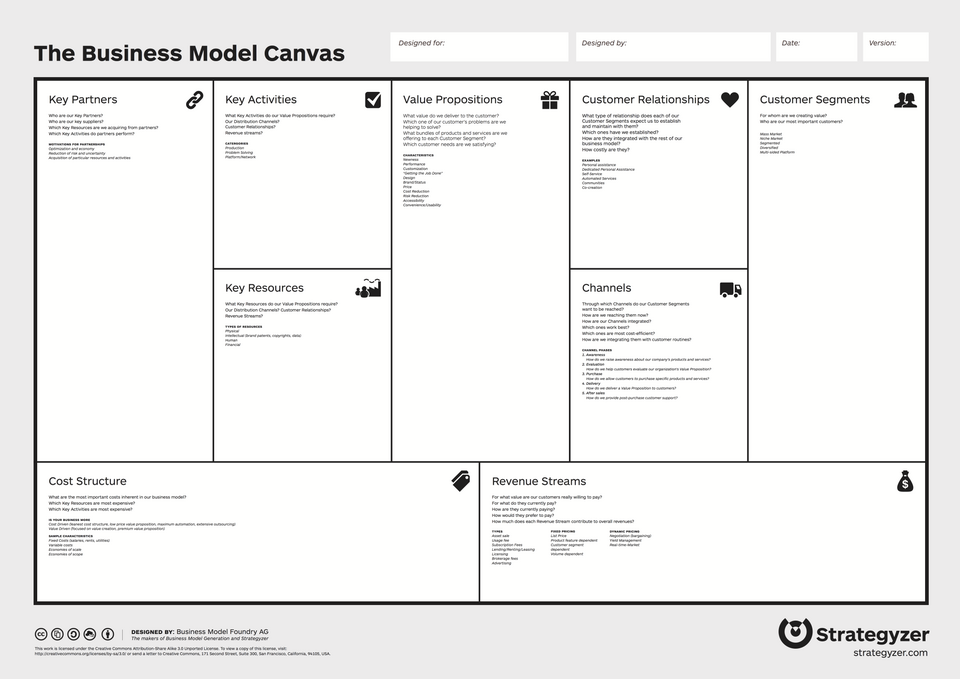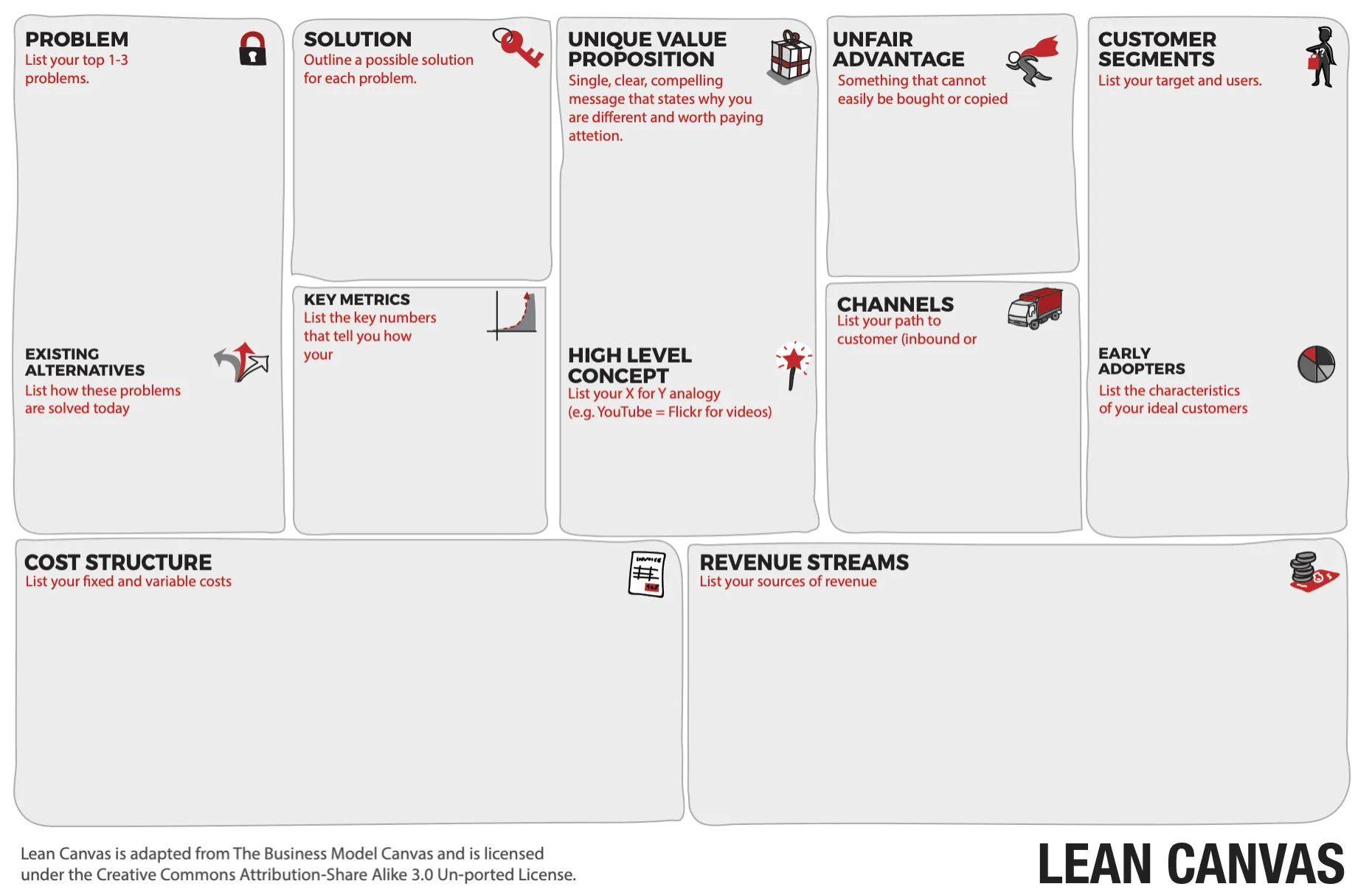
Create a compelling *Business Model*




How to build Business Model
Once you’ve found a good solution for a problem, the next step is to build a business model around it. A business model explains:
- How you create value for your customers
- How you deliver that value to them
- How you keep some value for yourself (make money)
Every successful business, big or small, runs on a business model (or several models for different parts of the business). As an entrepreneur, it’s crucial to clearly define your business model so you understand how your solution can become a successful business.
There are various ways to think about a business model. One of the most effective frameworks is described and illustrated by Alexander Osterwalder and Yves Pigneur in their best-selling book Business Model Generation. They liken a business model to a puzzle with 9 essential pieces. When all the pieces fit together properly, you have a complete picture of how your business works. Here's a brief overview of each piece:
The Customer Side:
- Customer Segments - Who exactly are you serving? (Not "everyone")
- Value Propositions - What problem are you solving for them?
- Channels - How do you reach these customers? (Website, stores, social media)
- Customer Relationships - How do you keep customers happy and coming back?
The Money Side:
- Revenue Streams - How do you actually make money from your customers?
- Cost Structure - What does it cost to run your business?
The Operations Side:
- Key Resources - What do you absolutely need? (People, equipment, technology)
- Key Activities - What are the most important things you do every day?
- Key Partnerships - Who helps you succeed? (Suppliers, distributors, etc.)
Business Model Canvas

The Business Model Canvas is a great starting point, but in the startup world, you might encounter different challenges. This is why Ash Maurya, the author of Running Lean, made some strategic changes, removing four boxes from the original canvas and adding four new ones that better capture startup risks, resulting in the Lean Canvas.
The Business Model Canvas can assist you in answering the question: "How does this business operate?" Meanwhile, the Lean Canvas focuses on identifying "What are our most significant assumptions and how do we validate them?"

What Lean Canvas adds:
- Problem - Most startups fail because they build the wrong thing, not because they can't build
- Solution - Keep it small to avoid falling in love with your first idea
- Key Metrics - Focus on the one number that actually matters (not vanity metrics)
- Unfair Advantage - What prevents copycats from eating your lunch?
What Lean Canvas ommits:
- Key Activities & Key Resources - Less relevant when you're testing, not operating
- Customer Relationships - Better captured through direct customer development
- Key Partnerships - Premature focus for early-stage startups
These key differences make the Lean Canvas an excellent tool for developing a business model for early-stage founders. In contrast, the Business Model Canvas is best used as a strategic communication tool with external partners such as investors, advisors, customers, and other stakeholders.
Do I need to write it down?
Many people see the concept of a business model negatively, thinking it’s just an academic exercise. However, we believe it’s important to engage in this process regularly. The real advantage is treating your business model as something that changes over time. Once you have your first version, you can track progress, evaluate results, and improve your strategy.
How to build Business Model
Once you’ve found a good solution for a problem, the next step is to build a business model around it. A business model explains:
- How you create value for your customers
- How you deliver that value to them
- How you keep some value for yourself (make money)
Every successful business, big or small, runs on a business model (or several models for different parts of the business). As an entrepreneur, it’s crucial to clearly define your business model so you understand how your solution can become a successful business.
There are various ways to think about a business model. One of the most effective frameworks is described and illustrated by Alexander Osterwalder and Yves Pigneur in their best-selling book Business Model Generation. They liken a business model to a puzzle with 9 essential pieces. When all the pieces fit together properly, you have a complete picture of how your business works. Here's a brief overview of each piece:
The Customer Side:
- Customer Segments - Who exactly are you serving? (Not "everyone")
- Value Propositions - What problem are you solving for them?
- Channels - How do you reach these customers? (Website, stores, social media)
- Customer Relationships - How do you keep customers happy and coming back?
The Money Side:
- Revenue Streams - How do you actually make money from your customers?
- Cost Structure - What does it cost to run your business?
The Operations Side:
- Key Resources - What do you absolutely need? (People, equipment, technology)
- Key Activities - What are the most important things you do every day?
- Key Partnerships - Who helps you succeed? (Suppliers, distributors, etc.)
Business Model Canvas

The Business Model Canvas is a great starting point, but in the startup world, you might encounter different challenges. This is why Ash Maurya, the author of Running Lean, made some strategic changes, removing four boxes from the original canvas and adding four new ones that better capture startup risks, resulting in the Lean Canvas.
The Business Model Canvas can assist you in answering the question: "How does this business operate?" Meanwhile, the Lean Canvas focuses on identifying "What are our most significant assumptions and how do we validate them?"

What Lean Canvas adds:
- Problem - Most startups fail because they build the wrong thing, not because they can't build
- Solution - Keep it small to avoid falling in love with your first idea
- Key Metrics - Focus on the one number that actually matters (not vanity metrics)
- Unfair Advantage - What prevents copycats from eating your lunch?
What Lean Canvas ommits:
- Key Activities & Key Resources - Less relevant when you're testing, not operating
- Customer Relationships - Better captured through direct customer development
- Key Partnerships - Premature focus for early-stage startups
These key differences make the Lean Canvas an excellent tool for developing a business model for early-stage founders. In contrast, the Business Model Canvas is best used as a strategic communication tool with external partners such as investors, advisors, customers, and other stakeholders.
Do I need to write it down?
Many people see the concept of a business model negatively, thinking it’s just an academic exercise. However, we believe it’s important to engage in this process regularly. The real advantage is treating your business model as something that changes over time. Once you have your first version, you can track progress, evaluate results, and improve your strategy.

%201.svg)